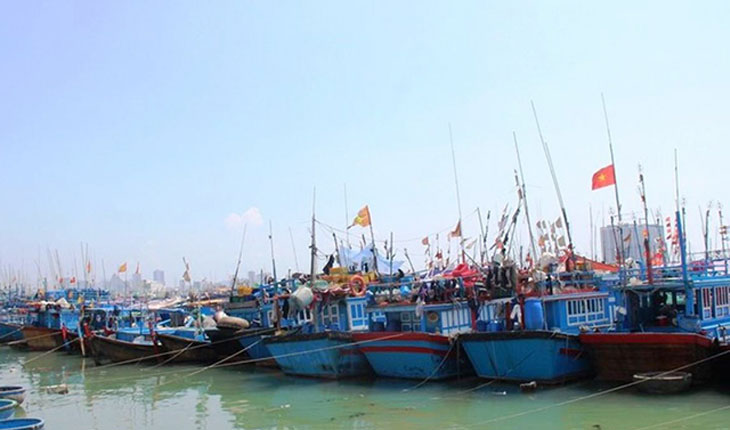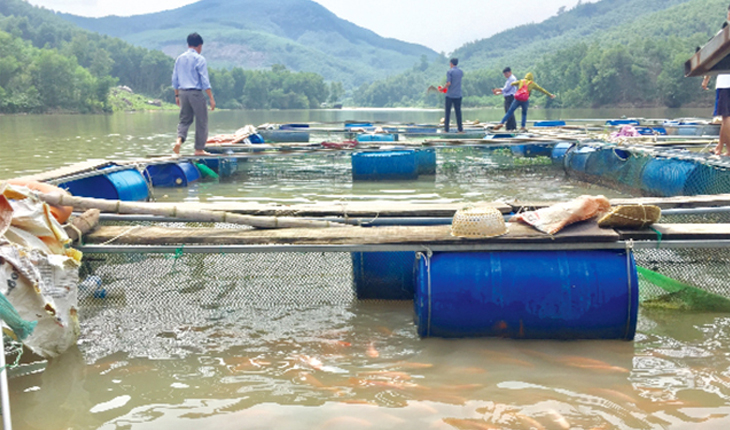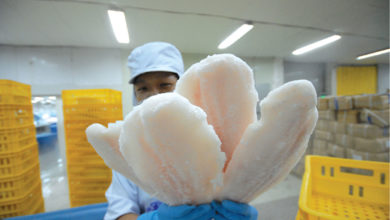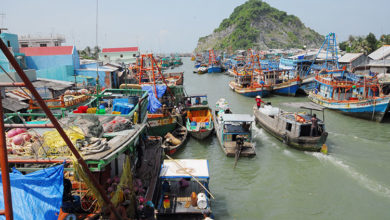Global Warming Promises to Change Fish and Shrimp Farming
Sustainable aquaculture is threatened by climate change. Here are ways climate poses a threat to shrimp and fish farming, and what the industry can do to adapt to the threat.
In Brief
+ Climate change is one of the biggest challenges the world is facing in the 21st century, and it is a direct threat to food security.
+ Climate change affects aquaculture by impacting water temperature, algal blooms, global changes in sea levels and regional or local level extreme climate events. These changes can make aquatic species more susceptible to diseases.
+ It will also affect feed formulations that rely on ingredients of plant origin. Feed of plant origin is vulnerable to mycotoxin contamination, and climate change has been increasing the mycotoxin threat. Mycotoxins’ negative effects in fish and shrimp range from acute mortality to chronic reduction in immunity, fecundity and performance.
+ Aquaculture must ‘adapt or die’ and, for the producer, this may include real time monitoring, automation, digitalization, using efficient feeds and employing prophylactic health management programs.
Climate change is a reality that threatens food security and requires us in the aquaculture industry to adapt in numerous ways. According to the World Health Organization in 2018, “In the last 130 years, the world has warmed by approximately 0.85oC. Each of the last three decades has been successively warmer than any preceding decade since 1850. Sea levels are rising, glaciers are melting and precipitation patterns are changing. Extreme weather events are becoming more intense and frequent.”
We have recently reached a turning point where policy, legislation, industrial growth and technology have been challenged. Increased awareness and concern have manifested in many demonstrations, e.g. Fridays for Future, often led by youth around the world. Indeed, in the mainstream population, we now understand the scientific, economical and often personal detail, that climate change influences us all.
Climate change is a direct threat to food security. Indeed, one of the most pressing challenges we face is how to feed an ever-increasing population without increasing our ecological or environmental footprint. This is where aquaculture comes in. Aquaculture has grown and consequently, how it may affect climate change is in the public spotlight . Generally public opinion now realizes that aquaculture is one of the most sustainable solutions for healthy nutrition. Yet, it is also pertinent to consider how climate change will affect the aquaculture industry.
We All Must Eat
There are many points where climate change ’meets’ aquaculture, from water temperature to algal blooms, global changes in sea levels and regional or local level extreme climate events.
Regardless of cultured species, every animal must eat, so we must first consider the implications of climate change, directly or indirectly, on aquafeeds. A common trend now in aquafeeds is reformulating with more sustainable ingredients, particularly with lower reliance on marine lipid and protein sources.
As well as emerging novel ingredients (e.g. insects, single cell proteins, etc.), many formulations currently rely on plant-based proteins. Consequently, the influence of climate change on related agricultural commodities such as soy, wheat, corn, rice and others will directly affect aquatic production. Since aquatic species are generally poikilothermic, their metabolism also changes with temperature. This is one reason why some feed manufactures produce feeds for specific seasons, and these may become more popular if we see more extreme weather.

Weather, Fungi & Toxins
A major outcome of changing weather patterns on crops used in the aquafeed industry is the increased growth and change of distribution patterns of harmful fungi and molds, which not only affect the crop directly, but also produces secondary toxic metabolites known as mycotoxins.
Among the major toxigenic fungi to contaminate crops are members of the genera Aspergillus (producing aflatoxins, ochratoxins,) Claviceps (ergot alkaloids) Penicillium (ochratoxin, patulin) and Fusarium (fumonisins, zearalenone, deoxynivalenol, T-2 toxin). The biological mechanisms leading to mycotoxin production directly responds to environmental conditions. Research shows direct connection between climatic region to toxin dynamics.
For instance, aflatoxins and fumonisins are generally considered common tropic and subtropic toxins while deoxynivalenol is more often the dominant toxin in temperate climate regions. In recent years however, survey programs reveal that these dynamics and distributions are changing, highlighting the need for further mitigation measures.

Mycotoxins Harm Aquatic Species
The severity of fungal infestation and subsequent mycotoxin contamination is governed by many factors like temperature, humidity and insect-crop damage. Moreover, these molds may develop post-harvest, during crop storing and processing especially when water activity is high. Mycotoxins are extremely stable to physiochemical treatments and their presence in the crops without proper mitigation leads directly to their consumption by the farmed animals, impacting health and production.
These negative effects in aquatic species range from acute mortality to chronic reduction in immunity, fecundity and performance, these are becoming even more pronounced once the animal is facing additional biological (e.g. pathogen) or environmental stressors, the latter of which is primarily climate driven.
Climate & Disease
Climate is not just determining environmental conditions, it is also implicated in disease. For example, the Brazilian tilapia industry is fighting two major diseases. In the winter months, francisellosis, caused by Francisella spp., is particularly problematic, whilst in the summer months the main challenge comes from Streptococcus spp. (causing streptococcosis).
Since the etiological agents are defined by different characteristics, in this case Gram-negative vs Gram-positive bacteria, producers must use different management strategies to control their impact. From experience, it is evident that organic acids can combat better Gram-negative pathogens (Figure 1), whilst phytogenic feed additives may be more effective against Gram-positive bacterial threats (Figure 2). A similar temperature effect can be seen for other pathogen types, for example white spot syndrome virus (WSSV) in shrimp appears to be more serious in temperatures below 30°C rather above 30°C.
Rainfall can also have a great impact in shrimp culture; increased rainfall will lead to a reduction in salinity, whilst a lack of rainfall may lead to increase in salinity, especially in combination with hot weather where evaporation is high. Since Vibrio spp. are affected by salt concentration, it follows that fluctuating salinity may affect their abundance, not to mention impacting shrimp ability to osmoregulate effectively.
This means that changing weather patterns may alter the expected disease season, and geographical range of pathogens and their respective pathologies may change. This unpredictability makes it even more important for producers to employ robust disease prevention strategies, for example biosecurity, SPF/ SPR animals, water management and usage of functional feeds.
Can Aquaculture Mitigate Climate Change?
Although it is not clear how climate change will affect the biology of commercially important aqua species, it is certain that climate change will have an impact on aquaculture. But in some ways, aquaculture may be capable of mitigating some of the negative effects.
For example, healthy tropical rainforests are a crucial carbon sink, slowing climate change by removing carbon from the atmosphere and storing it in trees, a process known as carbon sequestration. These precious ecosystems must be protected, so instead of agriculture-based deforestation, it makes sense to focus animal production in other areas which are more resilient to these effects, for example in the open ocean.
It is also worth considering that many climate change ‘events’ are land based, e.g. desertification, drought, tornadoes etc. so open ocean aquaculture may not be directly affected. Certain species, for example salmon also have an extremely low carbon footprint. The Global Salmon Initiative reported that a 40g serving of farmed salmon, produces 0.60 g CO2eq, compared to 0.88 g for chicken, 1.30 g for pork and 5.92 g for beef (Figure 3). This makes it one of the most environmentally sustainable animal proteins to consume. It should be noted however that other aquatic species have a greater environmental cost.
What Can We Do?
First and foremost, we can all adopt immediate measures to minimize our contribution to climate change in our professional and personal life. From sustainability to carbon neutralization, awareness, education and research are the foundation for a long-term change and should always go hand in hand with our decision making and actions.
As we have seen recently, the global shut down of non-essential industry has seen record low levels of pollution and greenhouse gases. This has led many experts to postulate if these events can be the spur to a green recovery. It would be encouraging to think that as society resumes its ‘normal’ life, aquaculture can also cement its position as a sustainable animal production sector for better food security. To succeed in this regard, and with climate change in mind, every part of the value chain must play its part, from equipment, technology and feed suppliers, to producers, legislators and the consumer.

Aquaculture must ‘adapt or die’, and the challenge of climate change could force the industry to become more sustainable and efficient. Regardless of the specific climate change effect, it is universally accepted that many activities, including aquaculture, will become more unpredictable and therefore, we must consider how to increase production predictability and reduce the risk. Ultimately for the producer, this may include real time monitoring, automation, digitalization, using efficient feeds and employing prophylactic health management programs.
It will also be important to consider other factors such as genetic programs for more robust animals as well as production system (indoor vs outdoor for shrimp), site (coastal or open ocean for marine species), and perhaps even choice of species. With these factors in mind, only with a holistic approach can we work towards a productive, profitable and an environmentally conscious aquaculture sector.
Biomin.net









